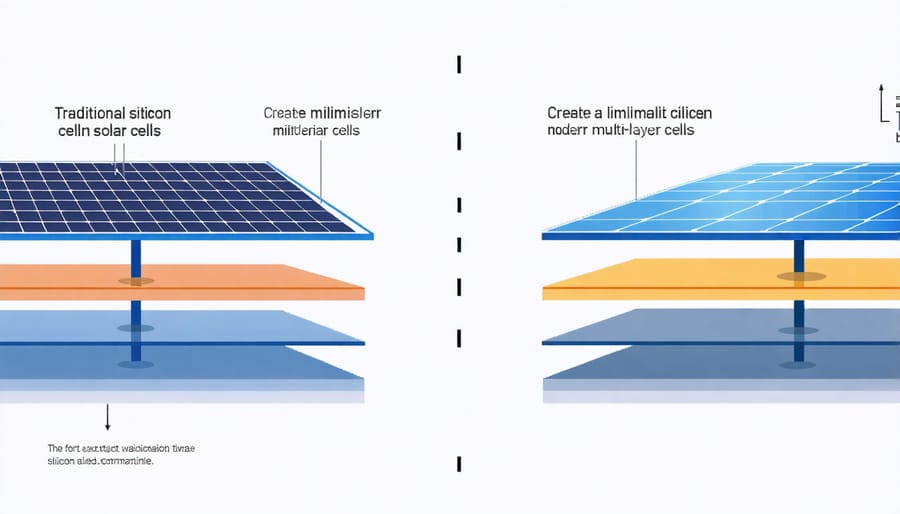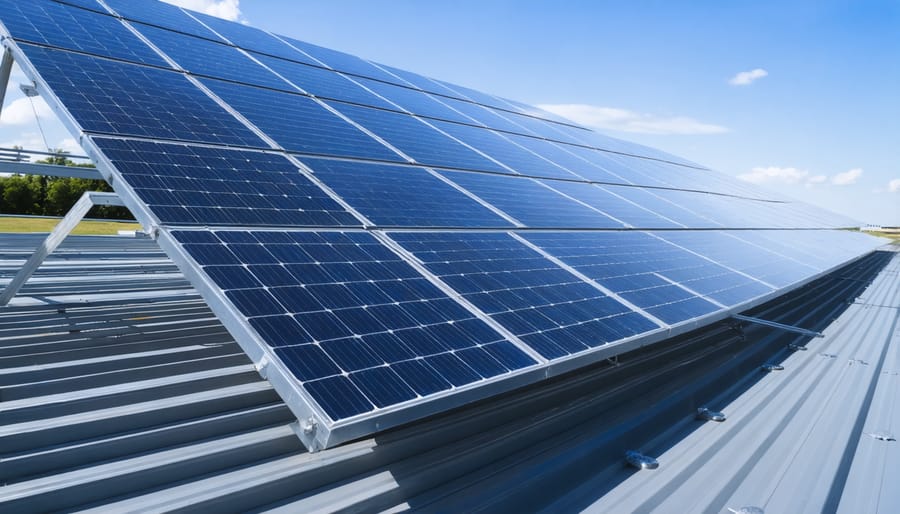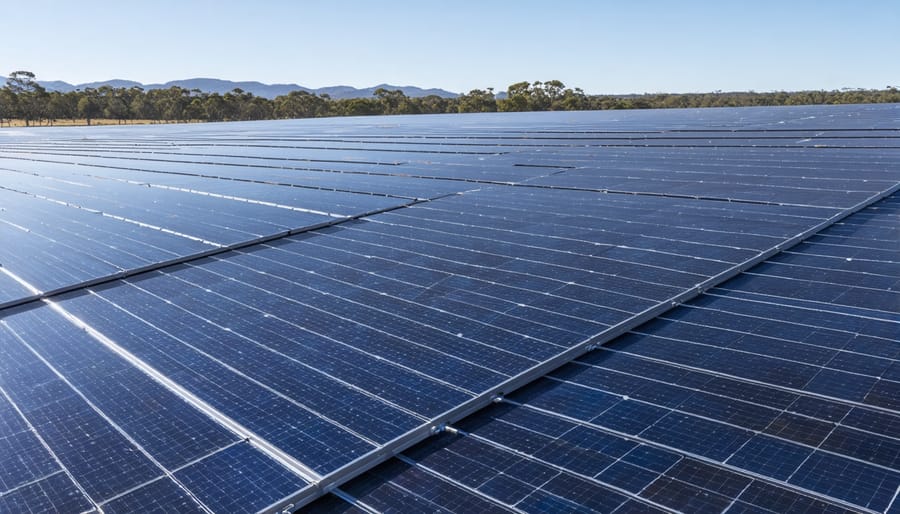Groundbreaking advances in solar technology are revolutionizing Australia’s renewable energy landscape, pushing panel efficiency beyond 26% and slashing energy costs for homeowners and businesses alike. From perovskite-silicon tandems achieving record-breaking conversion rates to innovative anti-reflective coatings that capture previously lost sunlight, these improvements represent a decisive shift in solar’s competitiveness against traditional energy sources.
Recent breakthroughs in material science have transformed laboratory possibilities into commercial realities. Australian researchers at UNSW have pioneered multi-junction cells that harness a broader spectrum of sunlight, while local manufacturers are implementing advanced tracking systems that boost daily energy yields by up to 45%. These developments arrive at a crucial moment, as our nation leads the global transition toward sustainable energy solutions.
The impact extends beyond pure efficiency gains. Modern solar installations now feature self-cleaning surfaces, intelligent power optimization, and enhanced durability that significantly reduce maintenance costs while extending operational lifespans. For Australian households and industries investing in solar technology, these improvements translate into faster returns on investment and increased energy independence, marking a new chapter in our renewable energy journey.
The Current State of Solar Panel Efficiency
Traditional Silicon Solar Cells: Benefits and Limitations
Traditional silicon solar cells have been the backbone of solar power applications for decades, offering reliable performance and steadily decreasing costs. These conventional panels, which dominate the Australian market, typically achieve efficiency rates between 15% and 20% in real-world conditions, making them a practical choice for both residential and commercial installations.
The main benefits of traditional silicon cells include their proven durability, widespread availability, and established manufacturing processes, which have helped drive down costs significantly over the past decade. They perform particularly well in Australia’s sunny climate, providing consistent energy generation throughout our long summer days.
However, these conventional cells face certain limitations. The theoretical maximum efficiency for single-junction silicon solar cells, known as the Shockley-Queisser limit, caps at around 33%. Current commercial panels operate well below this ceiling, primarily due to factors like electron recombination, reflection losses, and the inability to capture the full solar spectrum. Additionally, their performance can degrade in extreme heat, which is particularly relevant for Australia’s climate.
Despite these constraints, ongoing innovations in silicon cell design and manufacturing continue to push efficiency boundaries while maintaining cost-effectiveness.

Why Material Innovation Matters
The heart of solar efficiency lies in the materials used to capture and convert sunlight into electricity. Advanced materials are revolutionising the solar industry, pushing the boundaries of what’s possible in renewable energy generation. These innovations are particularly crucial for Australia, where abundant sunshine provides immense potential for solar power.
New-generation photovoltaic materials are breaking efficiency records previously thought impossible. Through clever engineering at the molecular level, researchers have developed materials that can capture a broader spectrum of sunlight, reducing energy loss and increasing power output. These improvements mean more energy generated from the same amount of sunlight – a game-changer for both residential and commercial installations.
Materials innovation also drives down costs while improving durability. Modern solar panels using advanced materials can withstand harsh Australian conditions better than ever before, from the scorching heat of the outback to the salt spray along our coastlines. This enhanced durability translates to longer-lasting systems and better returns on investment.
Perhaps most exciting is how material advances are opening doors to new applications, like transparent solar cells for windows and flexible panels that can be integrated into building materials. These innovations are transforming how we think about solar energy implementation in our communities.
Game-Changing Advanced Materials
Perovskite Solar Cells
Perovskite solar cells represent one of the most exciting breakthroughs in solar technology, showing remarkable potential to revolutionise the renewable energy landscape in Australia. These innovative materials have achieved impressive efficiency improvements in laboratory settings, jumping from just 3.8% in 2009 to over 25% in recent years – a pace of development that’s unprecedented in the solar industry.
What makes perovskite technology particularly promising is its flexibility and cost-effectiveness. Unlike traditional silicon cells, perovskites can be manufactured using simple, room-temperature processes and can be printed onto flexible surfaces. This means we could potentially see solar cells integrated into windows, building materials, and even clothing in the near future.
Australian researchers are at the forefront of perovskite development, with several universities working on solving the technology’s main challenges: stability and durability. Recent breakthroughs at the University of Sydney have shown promising results in extending the lifespan of perovskite cells, bringing us closer to commercial viability.
The most exciting aspect is the potential to combine perovskites with existing silicon solar cells to create tandem devices. These hybrid cells could potentially achieve efficiency rates above 30%, significantly outperforming current commercial panels. With Australia’s abundant sunshine and strong solar industry, perovskite technology could help cement our position as a renewable energy powerhouse.

Multi-Junction Solar Cells
Multi-junction solar cells represent a groundbreaking leap forward in solar technology, offering significantly higher efficiency rates than traditional single-layer panels. By stacking multiple layers of photovoltaic materials, each designed to capture different portions of the solar spectrum, these innovative cells can convert a broader range of sunlight into electricity.
Think of these cells as a solar sandwich, where each layer works together to maximize energy harvesting. The top layer typically captures high-energy blue and green light, while lower layers collect lower-energy red and infrared light that passes through the upper layers. This clever design allows multi-junction cells to achieve efficiency rates above 40% in laboratory conditions, more than double that of conventional silicon panels.
Australian researchers at the University of New South Wales have been at the forefront of developing this technology, achieving world-record efficiency levels. Their work has shown particular promise for concentrated photovoltaic systems, which are ideal for Australia’s sun-drenched climate.
While currently more expensive than traditional panels, multi-junction cells are proving their worth in specialized applications, such as spacecraft and high-performance solar installations. As manufacturing processes improve and costs decrease, these high-efficiency cells are becoming increasingly viable for commercial and residential use, offering a glimpse into the future of solar energy in Australia.
Quantum Dot Technology
Quantum dot technology represents one of the most exciting breakthroughs in solar panel efficiency. These tiny semiconductor particles, smaller than a human hair’s width, are revolutionizing how we capture and convert sunlight into electricity. When integrated into traditional solar panels, quantum dots can capture a broader spectrum of light, including wavelengths that conventional panels typically miss.
Australian researchers at the University of Queensland have been at the forefront of quantum dot development, creating panels that can harvest infrared light – effectively generating power even on cloudy days. This breakthrough is particularly valuable for our diverse climate conditions, from the sunny outback to overcast coastal regions.
The real game-changer is quantum dots’ ability to overcome the Shockley-Queisser limit, the theoretical maximum efficiency of traditional silicon solar cells. By using a process called ‘multiple exciton generation,’ quantum dots can potentially convert a single photon into multiple electrons, pushing efficiency rates beyond 30%.
Several Australian solar farms are already testing quantum dot-enhanced panels, with promising results showing up to 20% improvement in energy capture during early morning and late afternoon hours. This technology isn’t just about peak performance – it’s about extending the productive hours of solar collection, making solar power more reliable and cost-effective for everyday Aussies.
The future looks bright as manufacturers work to scale up production and bring quantum dot solar technology to the mainstream market, potentially revolutionizing our renewable energy landscape.
Real-World Applications and Success Stories
Commercial Solar Installations
Australia’s renewable energy landscape is being transformed by innovative utility-scale solar installations that showcase the latest advances in solar technology. The Western Sydney Solar Farm stands as a prime example, utilizing high-efficiency bifacial panels that capture both direct sunlight and reflected light from the ground, boosting energy yield by up to 30%.
In Queensland’s Sunshine Coast, the Valdora Solar Farm demonstrates the effectiveness of advanced anti-reflective coatings and smart tracking systems. These innovations have helped the facility achieve a remarkable 20% increase in energy production compared to conventional installations. The project employs next-generation monocrystalline panels with PERC (Passivated Emitter and Rear Cell) technology, setting new benchmarks for commercial solar efficiency.
The Desert Knowledge Australia Solar Centre in Alice Springs serves as a testing ground for cutting-edge materials in harsh conditions. Here, researchers are field-testing panels with self-cleaning nanocoatings that reduce dust accumulation and maintain optimal performance even in the challenging outback environment. The facility’s data shows these advanced materials can preserve up to 95% of panel efficiency throughout the year.
These commercial installations are proving grounds for emerging technologies, demonstrating how innovative materials can significantly boost solar energy production while reducing maintenance costs and extending system longevity.

Residential Success Stories
The Thompson family in Brisbane showcases how cutting-edge solar technology can transform a typical suburban home. After installing new-generation perovskite-silicon tandem solar panels in 2022, they saw their energy production increase by 28% compared to their previous system. “We’re now generating enough power to run our home and charge our electric vehicle, with surplus energy to spare,” says Sarah Thompson.
In Adelaide, the Martinez household became one of the first in their area to implement bifacial solar panels with advanced anti-reflective coatings. Their system’s unique design captures both direct sunlight and reflected light from their light-colored patio, boosting their energy yield by 25% during peak hours. The family reports saving over $2,800 annually on their energy bills.
The Wilson residence in Perth demonstrates how smart solar technology integration can maximize efficiency. Their installation combines high-efficiency panels with AI-powered microinverters that adjust power conversion rates based on weather conditions. During the summer months, their system consistently achieves a remarkable 23% efficiency rate, well above the industry standard.
These success stories highlight how emerging solar technologies are making a real difference in Australian homes. The combination of new materials and smart systems is helping homeowners achieve greater energy independence while contributing to a more sustainable future.
Future Prospects and Implementation
Emerging Technologies
Exciting breakthroughs in solar technology are reshaping the future of renewable energy in Australia. Perovskite solar cells, a revolutionary material that can be printed like newspapers, are showing promise with efficiency rates approaching 30%. These cells could dramatically reduce manufacturing costs while boosting energy generation capacity.
Quantum dot technology is another game-changer, allowing panels to capture a broader spectrum of light, even on cloudy days. When combined with advanced energy storage solutions, these innovations could revolutionize how we harness solar power.
Australian researchers are also developing transparent solar cells that can be integrated into windows and building materials, effectively turning entire structures into power generators. Meanwhile, bifacial solar panels, which capture light from both sides, are showing efficiency improvements of up to 30% compared to traditional panels.
These emerging technologies aren’t just laboratory curiosities – they’re rapidly moving toward commercial viability, promising to make solar power more accessible and efficient for homes and businesses across the country.
Making the Switch
Upgrading your solar installation to incorporate advanced materials doesn’t have to be complicated or overwhelming. Start by conducting an energy audit of your current system to identify potential improvement areas. Many Australian solar providers now offer free assessments to help determine the most cost-effective upgrade path for your specific situation.
Consider a phased approach to modernisation. Begin with simple improvements like adding smart inverters or upgrading to bifacial panels, which can capture reflected sunlight from both sides. These incremental changes can provide immediate efficiency gains while spreading out the investment over time.
For maximum impact, look into AI-optimized solar systems that automatically adjust panel positioning and energy distribution based on weather patterns and usage habits. Many suppliers offer financing options and government rebates are available to help offset the initial costs.
Don’t forget to factor in maintenance requirements when selecting new materials. Modern perovskite-silicon panels, while highly efficient, may need more frequent cleaning than traditional panels. Working with certified installers ensures proper integration with your existing setup and compliance with local regulations.
The remarkable advancements in solar panel materials and technology have ushered in a new era of renewable energy efficiency. Through innovative applications of perovskites, quantum dots, and multi-junction cells, we’re witnessing unprecedented improvements in solar energy conversion rates. These breakthroughs aren’t just laboratory achievements – they’re transforming the way Australian homes and businesses harness the power of the sun.
The impact of these material innovations extends far beyond mere technical specifications. With conversion efficiencies now pushing past 40% in some applications, solar power is becoming increasingly competitive with traditional energy sources. This progress is particularly significant for Australia, where abundant sunshine and vast open spaces create perfect conditions for solar energy adoption.
For homeowners and businesses considering solar installation, there’s never been a better time to make the switch. The combination of improved efficiency, declining costs, and government incentives makes solar power an increasingly attractive investment. Success stories from across the country demonstrate how advanced solar technologies are helping Australians slash their energy bills while contributing to a cleaner environment.
Looking ahead, the future of solar efficiency appears incredibly bright. As researchers continue to push the boundaries of material science and engineering, we can expect even more impressive improvements in solar technology. By embracing these innovations today, we’re not just investing in better energy solutions – we’re helping to build a more sustainable future for generations to come.

